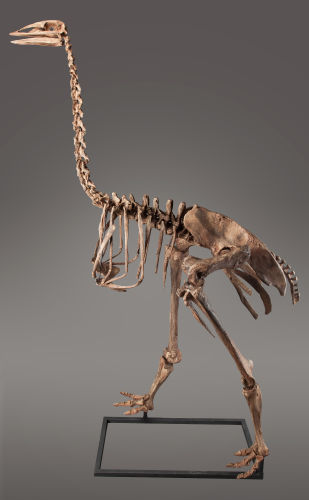As described in my previous post, DNA and anatomy suggests that large flightless birds, such as ostriches, emus and cassowaries, evolved from a common ancestor shared with tinamous, a group of quail-like birds. These birds, known as palaeognaths, all share a relatively reptilian-like jaw, unlike most other modern birds. Other large-bodied palaeognaths are known from the fossil record, some of which have gone extinct very recently.
One such lineage included the New Zealand moa (Dinornithoformes), a group of nine described species that reached up to 12 ft in height. The moa are the only birds known to have completely lost their wings, presumably as a result of remaining flightless throughout much of their evolutionary history. Though a few reports suggest they may have survived until the 1800’s, they effectively went extinct around 1440. This occurred less than 200 years after the Maori people arrived in New Zealand, suggesting overpredation led to their demise.

Another major lineage of recently extinct palaeognaths is the elephant birds (Aepyornithoformes). These were similarly enormous birds, weighing up to half a ton, that lived on Madagascar and became extinct in the 1600’s or 1700’s.

Elephant birds maintain the world record for the largest known bird eggs: up to 3.3 ft in circumference, 13 inches long, 22 lbs, and a volume of approximately 160 times that of a chicken egg.
In addition to the New Zealand Moa and Malagasy elephant birds, all of today’s living palaeognaths live on southern continents: Africa (ostriches), South America (rheas, tinamous), and Australia, New Guinea and New Zealand (cassowaries, emu, kiwis). This is significant because all of these species are more genetically similar to each other than they are to any other birds.
One evolutionary model posits that a flighted palaeognath ancestor lived in the southern hemisphere, its descendant lineages dispersed to various southern continents, and many of these species became flightless over time. A flighted ancestry would explain why large-bodied palaeognaths possess tiny wings, even though they are incapable of flight. Alternatively, a creationist model suggests that all palaeognaths coincidentally headed south from Noah’s Ark, and flightless species somehow crossed oceans to arrive in Madagascar, New Guinea, Australia, New Zealand and South America.
Questions for Creationists
Why do all of the palaeognath birds live on southern continents? How did the flightless species cross oceans to get where they are today? Is it a coincidence that they are both more genetically similar to each other than to other birds and they all live on southern continents? Why would God create birds with wings that don’t allow them to fly?


Pingback: Fine Art of Paleontology – The Flightless Birds of the Southern Hemisphere – NATURES TALK SHOW, LLC